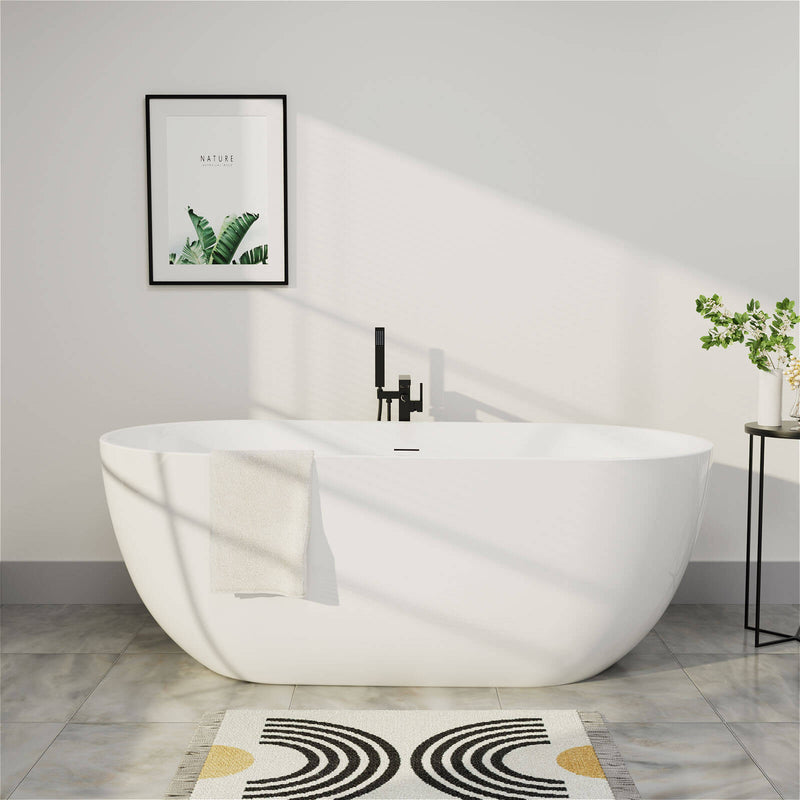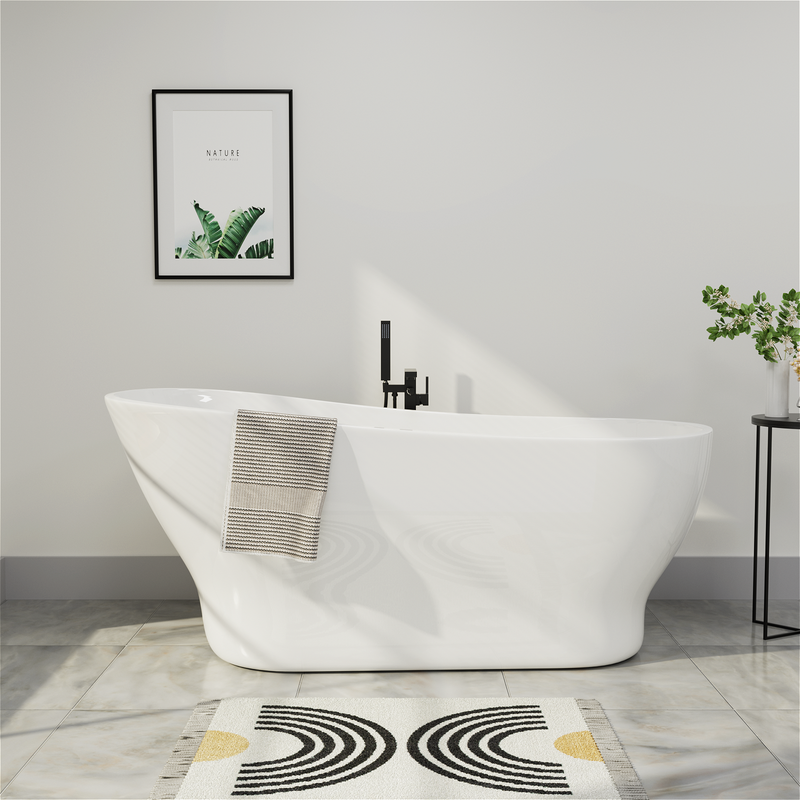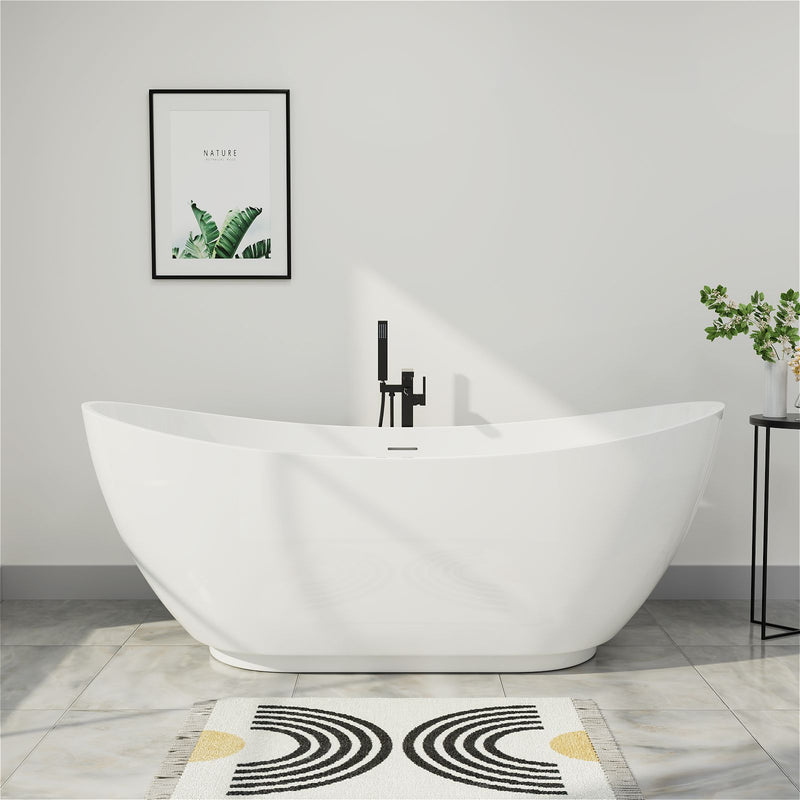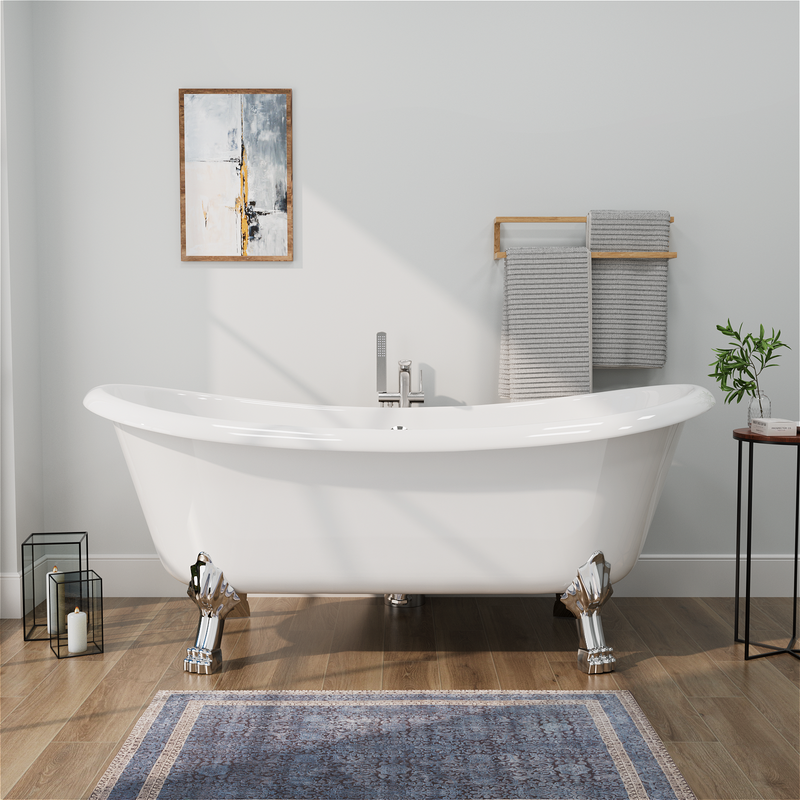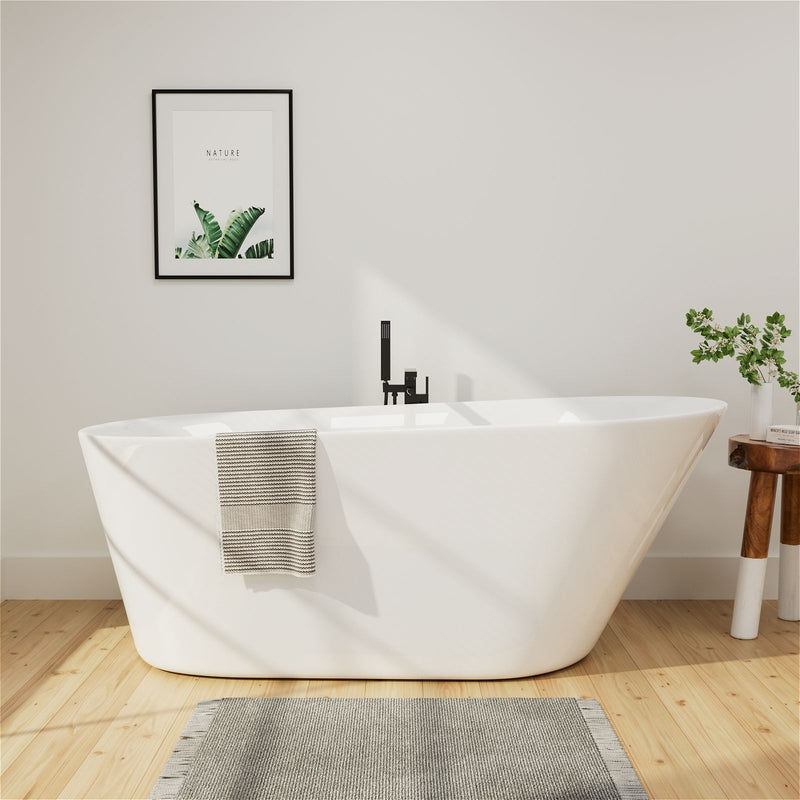For most homeowners, choosing the right bathtub (acrylic or ceramic) for their space can be quite difficult. If you are planning a bathroom renovation, then choosing the ideal bathtub is essential. A bathtub can completely change the look and feel of your bathroom. A beautiful and elegant bathtub can complement your bathroom design and make it the most charming place in your home. With the perfect bathtub, you will create a warm and cozy atmosphere in your bathroom, making it the perfect place to rest and relax.
When choosing the right bathtub, you definitely want it to last for a long time without any problems. It goes without saying that the lifespan of a bathtub depends largely on the material it is made of. The way you clean and maintain the bathtub also plays a major role. In fact, you should not only choose the best material available in the market, but also the one that is best for you and your family.
Acrylic and ceramic are two bathtub materials that are widely preferred by homeowners. Acrylic bathtubs are cheaper and easier to install. Ceramic bathtubs are more expensive and more difficult to install. If you are hesitating between the two bathtubs, you should know as much as you can about each material so that you can make a choice that you will never regret. So, let’s take a deep look at the advantages of each of these two materials. Hopefully, this article will help you find a bathtub that will beautify your bathroom and change your life.
What is an Acrylic Bathtub?
Acrylic bathtubs are made from a synthetic material called acrylic that is heated and molded into the desired shape. The finished product is lightweight and relatively affordable, making it popular with homeowners. After molding, acrylic bathtubs are reinforced with fiberglass to increase their durability.

Advantages of Acrylic Bathtubs
Lightweight: One of the biggest advantages of acrylic bathtubs is their light weight. Acrylic bathtubs are easier to transport and install than heavier ceramic or cast iron bathtubs.
Affordable: Acrylic bathtubs are generally more affordable, making them a great choice if you are on a tight renovation budget.
Variety of Styles: Acrylic is a versatile material that can be molded into a variety of shapes and sizes, offering a variety of design options to suit your bathroom style.
Warm to the Touch: Acrylic resin has good heat retention properties, so when you enter the bathtub, the surface of the bathtub will feel warmer and more comfortable.
Repairable: If scratches or damage occur on the surface of an acrylic bathtub, they can usually be repaired relatively easily. Minor blemishes can be removed by polishing or re-sanding.
Disadvantages of Acrylic Bathtubs
Scratches: Although easy to repair, acrylic bathtubs are more susceptible to scratches and dents than porcelain.
Less Durable: While they can last a long time with proper care, acrylic bathtubs are not as strong or durable as porcelain or cast iron alternatives.
Fade Over Time: With continued use and exposure to cleaning chemicals, the brightly colored surface of an acrylic bathtub may begin to fade or discolor.
What is a Porcelain Bathtub?
A porcelain bathtub is a solid surface bathtub made of materials such as formed steel, cast iron, glass, or tile that is coated with a layer of porcelain enamel. This coating makes the bathtub surface durable, scratch-resistant, and easy to clean and maintain. Porcelain bathtubs are known for their durability, scratch resistance, stain resistance, and resistance to fading.
The non-porous nature of porcelain prevents dirt from accumulating and inhibits the growth of mold and mildew. While porcelain tubs may be heavier and more expensive, their superior quality and easy-to-care features make them a great investment for those seeking a long-lasting, easy-to-maintain tub.
Advantages of Porcelain Tubs
Durable: Porcelain tubs are known for their durability. With proper care, a porcelain tub can last for decades without major repairs.
Scratch-Resistant: Porcelain enamel is highly resistant to scratching and chipping, helping to maintain its smooth, shiny finish.
Classic Look: Porcelain tubs have a timeless look and feel, making them a great choice if you want a more traditional or vintage style in your bathroom.
Easy to Clean: Porcelain’s non-porous surface is easy to clean and doesn’t stain easily, meaning that very little effort is required to keep it looking great.
Fade-Resistant: Unlike acrylic, porcelain retains its color and shine over time, so you don’t have to worry about discoloration or fading.
Disadvantages of Porcelain Tubs
Heavy: Porcelain tubs are much heavier than acrylic tubs. This can make installation more complicated and require additional support on the floor beneath the tub, especially in the case of an upstairs bathroom.
Expensive: Porcelain tubs are more expensive than acrylic tubs, so they may not be the best choice if you're looking to save money.
Cool to the Touch: Porcelain tubs may feel cool when you first step into them, which isn't ideal if you're looking for a nice, warm bathing experience. However, once you fill it with hot water, the material retains heat well.
Risk of Chipping: While porcelain doesn't scratch easily, it can easily chip if a heavy object is dropped. Once chipped, the underlying steel or cast iron may be exposed, which can easily rust if not handled properly.
What are the Main Differences Between Acrylic and Porcelain?

Acrylic tubs are made by bonding an acrylic finish to a fiberglass tub, while porcelain tubs are made by applying an enamel coating to an iron tub. Porcelain tubs are much heavier than acrylic tubs due to their construction, making them more difficult to install.
Porcelain is also a harder material than acrylic, which means their surfaces are more durable and scratch-resistant, although they can take a beating.
Here are the main differences between porcelain and acrylic that you should consider before buying.
Weight
Acrylic bathtubs have a significant weight advantage over ceramic bathtubs. Due to their lighter weight, acrylic bathtubs are more flexible in terms of installation and placement in the bathroom, and are easier to install than ceramic bathtubs. The lighter weight of acrylic bathtubs also makes them easier to handle and use. This advantage has led to more bathtubs in more shapes and sizes available on the market, providing more options for homeowners.
On the other hand, porcelain bathtubs are heavier, which limits their choice of shapes and sizes. The extra weight of the material makes it more challenging to install and operate. This limitation limits the options when choosing porcelain bathtubs of different sizes and shapes.
Acrylic bathtubs are lighter, more flexible, and easier to install, so there is a wider range of shapes and sizes to choose from. Ceramic bathtubs, on the other hand, are heavier, have limited options, and are more difficult to install.
Price
Acrylic bathtubs are more affordable than ceramic bathtubs. If you are looking for an affordable bathtub replacement solution that will not cost you too much, acrylic bathtubs are undoubtedly your best choice. Not only are acrylic bathtubs affordable, but they are also lighter, easier to handle and move, and will not cause damage even if they are accidentally dropped.
Ceramic bathtubs are generally more expensive than acrylic bathtubs. The higher price tag stems from the construction and materials used in ceramic tubs. Ceramic tubs also cost more to maintain than acrylic tubs, which adds to the overall cost. Ceramic tubs can also cost more to install because they are heavier and require extra precautions during installation.
Durability
Ceramic tubs are more durable than acrylic tubs and can last for decades with proper care. The material used in ceramic tubs is extremely resilient and won't break down as easily as acrylic tubs. If durability is your priority, then choosing a ceramic tub is a smart move.
However, it's worth noting that ceramic tubs are generally more expensive than acrylic tubs. This is because acrylic tubs are made of higher-quality, more durable materials. Acrylic tubs are more cost-effective and a more economical option. While acrylic tubs may not be as durable as ceramic tubs, they can last for many years with proper care. Acrylic tubs are also easier to clean and maintain than ceramic tubs.
Heat Retention
Acrylic tubs retain heat better than ceramic tubs. Acrylic has a low thermal conductivity, which means it doesn't conduct heat as easily as other materials, so the water in your tub stays warmer for longer. Therefore, acrylic bathtubs are a good choice for those who enjoy long, relaxing soaks.
The non-porous surface of acrylic bathtubs also helps maintain its heat-retaining properties. The smooth, shiny surface prevents heat from escaping out the sides of the tub, which helps maintain the water temperature.
Ceramic bathtubs are usually made of a ceramic coating that is usually applied to a cast iron or steel base, which has poor thermal insulation properties. Ceramic is dense and heavy, and does not insulate and retain heat as well as acrylic.
Maintenance
Porcelain bathtubs should be hand washed with a mild cleanser such as vinegar, lemonade, or soap. Never use steel wool or abrasive brushes, as they can scratch the surface of the porcelain. Proper care is essential to prevent long-term discoloration.
Acrylic bathtubs can be cleaned with commercial cleaners or mild detergents. Acrylic has a smooth, non-porous surface, making it easier to clean and maintain than porcelain. However, be sure to avoid using abrasive cleaning tools that can scratch the bathtub.
Installation
Acrylic bathtubs are lighter than porcelain bathtubs, making them easier to handle and install. However, due to their light weight, acrylic bathtubs are also more susceptible to cracking if not installed properly. Therefore, it is important to take good care of them and follow the correct installation procedures to minimize the risk of damage.
Porcelain bathtubs are generally more durable and less prone to cracking when installed due to their heavier, sturdier construction. The weight of the porcelain material provides additional strength and stability, reducing the possibility of damage during installation.
Acrylic vs Porcelain Bathtubs: Which Material Is Better?
Determine Your Bathroom Style

The choice between acrylic and porcelain will largely depend on the style of your bathroom.
Acrylic bathtubs have a sleek, modern look and come in a variety of shapes and sizes, making them perfect for modern bathrooms. Ceramic bathtubs, on the other hand, exude a classic elegance, making them perfect for traditional and vintage-style bathrooms.
Consider the aesthetic you want to create, as this choice will affect the overall vibe of your space.
Evaluate Your Needs
Evaluate your needs in terms of durability, maintenance, and how often the bathtub will be used.
Acrylic is more resistant to wear and tear and is easier to repair, while porcelain is more durable and has a more durable look. Acrylic may be a better choice for homes with children or pets because it is tough and easy to maintain.
Budget Considerations
If you have a limited budget, acrylic is often a more affordable option. However, if you are looking for a long-term investment and a classic look, porcelain may make up for its higher upfront cost.
The long-term costs of the two materials are also different—acrylic may require minor repairs, while porcelain may require occasional touch-ups.
FAQs
Q: Are fiberglass bathtubs lighter than acrylic bathtubs?
A: Yes, fiberglass bathtubs are generally lighter than acrylic bathtubs and easier to move when installed. However, they may not be as durable or heat-retaining as acrylic bathtubs.
Q: How long does an acrylic bathtub last?
A: With proper care, acrylic bathtubs can last 10 to 15 years or more. Cleaning them regularly and avoiding abrasive tools will help preserve the bathtub's appearance and extend its life.
Q: Will acrylic bathtubs turn yellow over time?
A: Some acrylic bathtubs may turn yellow over time, especially if exposed to harsh chemicals or UV rays. Cleaning them regularly and using a mild, non-abrasive cleaner can help prevent yellowing.
Q: How to tell if your bathtub is porcelain or enameled?
A: To determine if your bathtub is porcelain or enameled, place a magnet on the surface of the bathtub. Porcelain bathtubs usually have cast iron or steel bases that attract magnets, while acrylic or fiberglass bathtubs do not.
Q: How to determine what material your bathtub is made of?
A: To identify the material of a bathtub, consider its weight, appearance, and texture. Acrylic bathtubs are lightweight and feel warm and smooth, while porcelain bathtubs are heavier and have a cool and smooth surface. You can also consult a professional for a more accurate identification.

